Physical Address
304 North Cardinal St.
Dorchester Center, MA 02124
Although there is no consensus on the definition of hypotension in preterm infants, up to 50% of very low birth weight (VLBW) infants are diagnosed with hypotension, and about one-third of extremely preterm infants receive at least one vasopressor/inotrope medication during the first postnatal week.
There is an association between hypotension and brain injury and poor neurodevelopmental outcome. However, it remains unclear whether hypotension, its treatment, or both play a causative role.
Alteration in cerebral blood flow is implicated in the pathogenesis of brain injury, including peri/intraventricular hemorrhage (P/IVH). Studies using Doppler and near-infrared spectroscopy have demonstrated a period of hypoperfusion-reperfusion prior to the development of P/IVH.
The use of advanced technologies capable of diagnosing altered systemic and cerebral blood flow and the associated changes in brain function in the VLBW population in the first hours to days after delivery has increased in the last decade but still remains largely in the experimental arena.
Due to the limited available data from randomized control trials and the challenges associated with conducting such studies, hypotension and circulatory compromise management remain controversial. The best strategy involves identifying the underlying pathophysiology of the hypotension and circulatory compromise, selecting the supportive and pharmacological treatment with an appropriate profile for the pathophysiology, and titrating the therapy based on the response by close monitoring.
With the evolution of neonatology over the last few decades, improved methods of monitoring and more effective interventions have been developed to identify and manage the respiratory, fluid and electrolyte, and nutritional abnormalities frequently encountered in very low birthweight (VLBW) infants. However, the ability to continuously and effectively monitor the hemodynamic changes at the level of systemic and organ blood flow and tissue perfusion in the clinical setting is still limited. Yet, the advances achieved with the use of targeted neonatal echocardiography and other bedside, noninvasive continuous systemic, organ and tissue perfusion, and cerebral function monitoring modalities have ushered in a new era in developmental hemodynamics. The novel monitoring modalities include but are not restricted to electrical impedance velocimetry, continuous wave Doppler ultrasonography, near-infrared spectroscopy (NIRS), visible light spectroscopy, laser Doppler technology, and amplitude-integrated EEG (aEEG). Yet, with the improvements in hemodynamic monitoring and a better understanding of the principles of developmental cardiovascular physiology have come the realization that little is known about circulatory compromise and its effects on organ, especially brain blood flow, blood flow–metabolism coupling, and long-term outcomes. Although we can continuously and reliably monitor systemic blood pressure in absolute numbers and there are a great number of proposed interventions for “normalizing” it, blood pressure is only the dependent component among the three hemodynamic parameters regulating systemic perfusion. Accordingly, blood pressure is determined by changes in the two independent variables, cardiac output and systemic vascular resistance (SVR). Therefore, in addition to monitoring and maintaining perfusion pressure (blood pressure), the obvious goal is to preserve normal systemic and organ blood flow and thus tissue oxygenation especially in the vital organs, that is, the brain, heart, and adrenal glands. In this regard, especially for the brain, medicine is at an even greater disadvantage. For instance, measuring cerebral blood flow (CBF) is more complex than continuously measuring systemic blood flow (left ventricular output), which itself has remained a significant challenge. Assessment of systemic blood flow becomes even more complicated when shunting through the fetal channels (ductus arteriosus and foramen ovale) occurs during the first few postnatal days in the preterm neonate. Unfortunately, in the neonate, it is more complicated to detect clinical evidence of ischemia in the brain in a timely manner and as readily as in other organs, such as the heart, liver, and kidneys. In addition, distinct regions of the brain have different sensitivity to decreased oxygen delivery. Accordingly, injury to the normally less well-perfused white matter might occur before other regions suffer damage. Alterations in normal brain activity and seizures are clear signs of a pathologic process, but they can be difficult to recognize, especially in the VLBW neonate; although the use of aEEG might be helpful in this regard. As for seizures, by the time they are present, irreversible injury may have already occurred. Most importantly, the clinician faces the formidable task of effectively supporting and protecting the enormously complex developmental processes that take place in the brain of the preterm infant during the transitional period and beyond. In addition, the understanding of how to manage hemodynamic disturbances that affect CBF, flow-metabolism coupling, brain function and structure, and, ultimately, neurodevelopmental outcome, is limited.
The intent of this chapter is to review the information available on the definition of systemic hypotension and the pathogenesis, diagnosis, and treatment of early cerebral perfusion abnormalities that have been shown to precede intracranial hemorrhage and periventricular white matter injury (PWMI) in the VLBW infant. Because CBF, flow-metabolism coupling, and cerebral oxygenation in this population are such a complex topic, we focus our discussion on the first postnatal days, during which the cardiorespiratory transition from fetal to extrauterine life occurs and most early pathological processes take place. We discuss some of the bedside modalities potentially useful for identifying changes in CBF and cerebral oxygenation. Once a pathological process is identified, provision of coherent, safe, and effective means of treating it is crucial. We present a paradigm for the treatment of the pathological processes underlying clinically evident brain injury in the VLBW infant based on the most up-to-date monitoring and clinical evidence available. Unfortunately, only little evidence exists about the appropriateness and effectiveness of the current approaches to treatment of neonatal hypotension and cardiovascular compromise. In an area as controversial and complex as this one, it is important to always highlight the vast unknown as well as the little-known pieces of the puzzle. Our goal is to provide the practitioner with recommendations for establishing the diagnosis and treatment. However, the recommendations should only be considered guidelines. Finally, although the understanding of both the normal and pathological processes in the developing preterm brain is improving, the definitive, safe, and effective clinical approach remains elusive.
Hypotension, defined by population-based normative data , is present in up to 50% of VLBW infants admitted to the neonatal intensive care unit. About one-third of extremely preterm infants receive at least one vasopressor/inotrope medication during the first postnatal week. Hypotension in the immediate postnatal period has historically been thought to be one of the major factors contributing to central nervous system injury and eventual cerebral palsy and poor long-term neurologic outcome in VLBW neonates. Indeed, an association between hypotension and brain injury and poor neurodevelopmental outcome is well documented and forms the basis of therapeutic efforts to normalize blood pressure. However, causation has not been demonstrated between hypotension and poor neurodevelopment and thus one cannot infer that long-term neurodevelopmental outcomes will improve if hypotension is rigorously avoided. Therein lies the conundrum often faced by the neonatologist: when to treat early cardiovascular compromise in the VLBW neonate, what medication to use and how quickly to normalize blood pressure and CBF?
On the other hand, a prospective observational study of over one thousand infants less than 28 weeks’ gestation showed that early postnatal hypotension was not associated with poor outcomes. Retrospective studies have also raised additional concerns by finding an association between “treated hypotension” and poor neurodevelopmental outcomes. Of note is that the use of the definition “treated hypotension” in these studies has introduced an additional bias by implying that, in addition to or independent of hypotension, the treatment might be a factor contributing to the described association. Although the implication of the potential negative effects of treatment of hypotension is plausible and thus needs to be prospectively studied, at present no conclusion can be drawn especially since other investigators have reported essentially the opposite finding. , Unfortunately, all of the studies to date were uncontrolled, either retrospective or observational in nature, and hypotension was treated in one way or another. There are only two randomized controlled trials (RCT) published to date that had a no-treatment arm. , The first study found that, due to difficulties in obtaining informed consent in a timely fashion or refusal of enrollment by the attending neonatologist, these trials are not feasible to perform. The second trial randomized hypotensive preterm infants to dopamine or placebo for 2 hours. Thereafter, if mean blood pressure in mm Hg was less than the gestational age in weeks by more than five points and/or a combination of hypotension and criteria for poor perfusion were met, the addition of another vasopressor/inotrope or inotrope was allowed. The need for other pressors/inotropes for treatment of hypotension was significantly higher in the placebo arm (66% vs. 38%). However, like the previous study, this trial was terminated early due to difficulty in enrollment with only 7% of the target sample recruited. Hence, the study remained severely underpowered for the primary outcome of survival without significant brain injury.
Therefore it remains unclear whether hypotension, its treatment, or both are implicated (either negatively or positively) in the association with neurodevelopmental outcome. Interestingly, the follow-up study to a randomized prospective trial comparing the effectiveness of dopamine and epinephrine in increasing blood pressure and CBF in hypotensive VLBW neonates during the first postnatal day found that neonates who responded to dopamine or epinephrine had long-term neurodevelopment outcomes comparable to those of age-matched normotensive controls, and that patients who did not respond to vasopressor-inotrope treatment had worse long-term outcome. It’s important to note that, contrary to the RCT discussed earlier, this study required titrating the medications to achieve the target blood pressure range. These findings suggest that careful treatment of neonatal hypotension may not be harmful and may actually be effective. However, as the primary outcome measure of the original study was not long-term neurodevelopmental outcome, the follow-up study was not appropriately powered to put this concern to rest. Similarly, a retrospective study of dopamine-treated preterm infants of <28 weeks’ gestation found the failure to respond to dopamine treatment to be associated with almost a six-fold greater likelihood of developing peri-intraventricular hemorrhage (P/IVH), while a positive response was associated with a reduction in the risk of P/IVH. In contrast, the secondary analysis of a recent RCT of peripheral perfusion- versus blood pressure-based approach to circulatory management of preterm infants during the transitional period found a higher incidence of P/IVH in a subset of the blood pressure-based management group that had responded to the treatment (volume, pressors and/or inotropes). Although the reason for this discrepancy is unclear, differences in the choice and titration of vasopressor/inotropes and avoidance of the extremes in blood pressure may, at least in part, provide an explanation. ,
During the last decade, the trend toward less aggressive treatment of hypotension has provided a glimpse into the potential effects of the presence of sustained hypotension without clinical evidence of poor perfusion (“isolated hypotension”). For example, the analysis of the French national prospective population-based cohort study allowed for the matching of 119 extremely preterm infants with untreated isolated hypotension to 119 neonates who received treatment despite having no clinical evidence of poor perfusion. Thus in this study none of the patients included had any sign of inadequacy of cardiovascular function other than hypotension. Hypotension was defined as a mean blood pressure less than gestational age in weeks during the first three postnatal days. The findings revealed that the group treated for the “isolated hypotension” had a higher rate of survival without severe morbidity and a lower rate of severe P/IVH and cerebral injury. Interestingly, the association between treatment and better outcome was even stronger when hypotension was defined as a mean blood pressure in mm Hg less than gestational age in weeks by more than five points. Although this dose-effect relationship strengthens the possibility of causality, further studies are clearly needed to verify the impact of hypotension on long-term outcome.
Accordingly, we do not have evidence indicating that, in a given VLBW neonate, what blood pressure is associated with decreased oxygen delivery to the tissues including the brain and thus harm to the patient. In addition, there is no solid evidence that increasing blood pressure to the “normal” range will normalize oxygen delivery. A school of thought exists that because mean arterial pressure (MAP) is a dependent variable of the equation describing tissue perfusion (and thereby oxygen delivery), MAP is less important than other indirect clinical indicators of decreased perfusion such as capillary refill time (CRT), urine output, and lactic acidosis. This approach ignores the physiologic principle that a pressure gradient is necessary to drive flow (Poiseuille’s law). Simplistically, in order to provide blood flow to the brain, the systemic arterial pressure has to be higher than the intracranial pressure. In other words, if blood pressure drops below the intracranial pressure, there would not be any gradient to drive blood to the brain. Obviously, the dependent variables of systemic hemodynamics (cardiac output and SVR) determine blood pressure and thus tissue oxygen delivery. However, ignoring MAP itself, as sometimes implied in the literature, may not be prudent and even feasible. Furthermore, ignoring it will not refine perfusion and oxygenation of the developing brain to its essence. Instead, it will further limit our current ability to monitor the patients. Therefore in our opinion, blood pressure should be considered as one of the markers of adequacy of circulatory function but not the only or primary marker . Indeed, low blood pressure implies impairment of vasomotor tone, low cardiac output, or both. On the other hand, normal blood pressure indicates either normal cardiac output and vasomotor tone or a compensated state, in which either cardiac output is increased to compensate for the low vasomotor tone or the vasomotor tone is elevated to compensate for the low cardiac output ( Fig. 2.1 ). In older children and adults, vital organs are relatively protected in the compensated phase of shock. Unfortunately, this does not seem to be the case in the preterm, especially the very preterm infant as their forebrain may not have reached “vital organ” assignment immediately after delivery (see below). Hence the limitation of primarily relying on blood pressure monitoring in an effort to assess the adequacy of circulation.
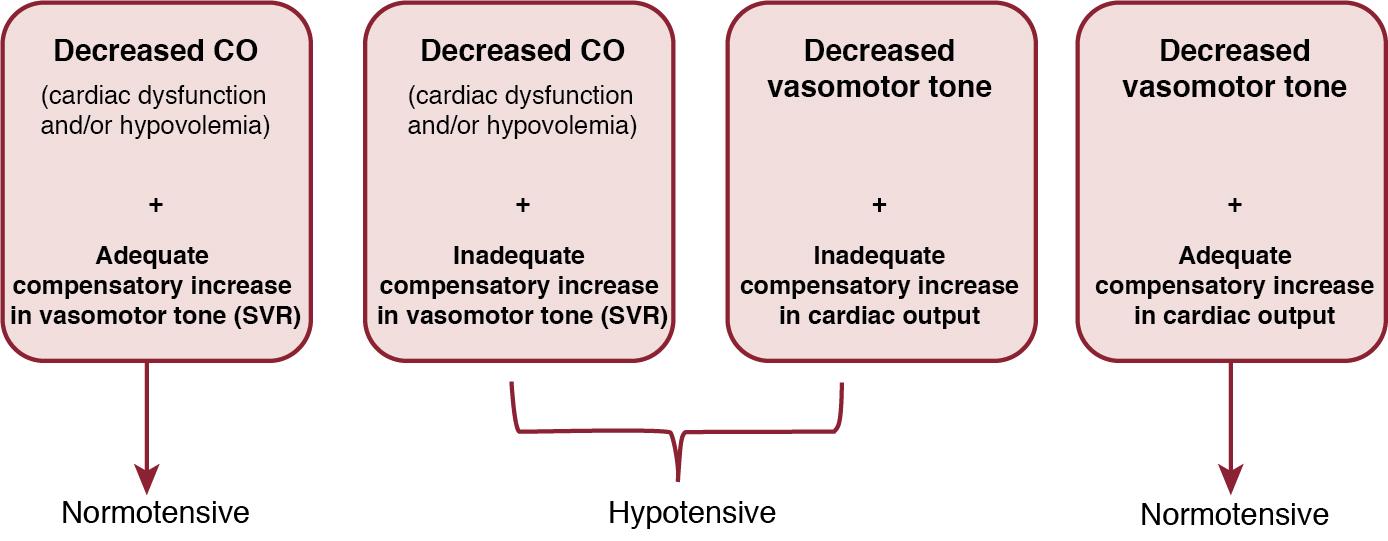
In clinical practice, hypotension is usually defined as the blood pressure value below the 5th or 10th percentile for the gestational and postnatal age–dependent normative blood pressure values ( Fig. 2.2 ). , Interestingly, findings of a recent study suggest that the normative values may actually be low, i.e., physiologically normal blood pressure in VLBW infants may actually be higher than has been commonly accepted. Moreover, due to the compensatory mechanisms, a certain blood pressure value in a given patient might be associated with normal oxygen delivery at one point in time while the same value may indicate true hypotension (abnormal tissue oxygen delivery) at another time. Accordingly, there is no consensus among neonatologists about the acceptable lower limit of systemic mean or systolic arterial blood pressure, and most units have different guidelines for the initiation of treatment of hypotension. From a pathophysiological standpoint, three levels of functional alterations of increasing severity can be used to guide the definition of hypotension ( Fig. 2.3 ). Findings of a small study underscore this point. However, it is important to keep in mind that no prospectively collected information is available on mortality and morbidity associated with the different proposed blood pressure thresholds.
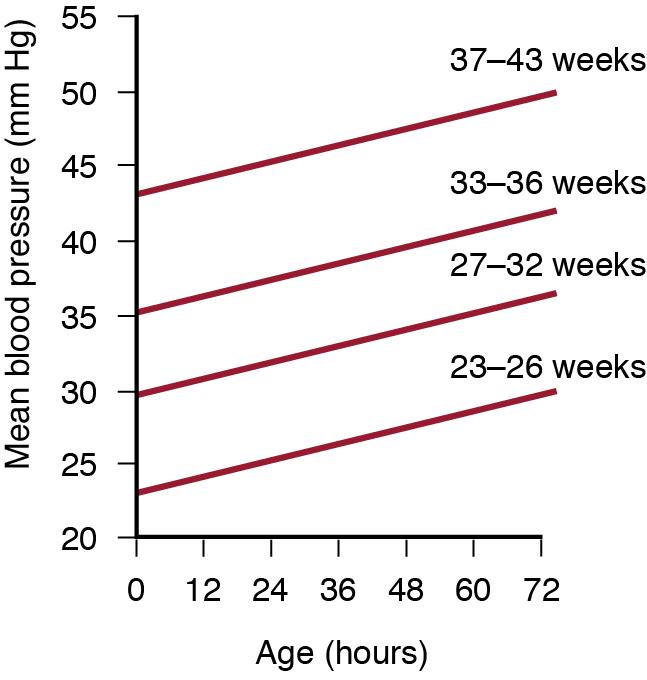
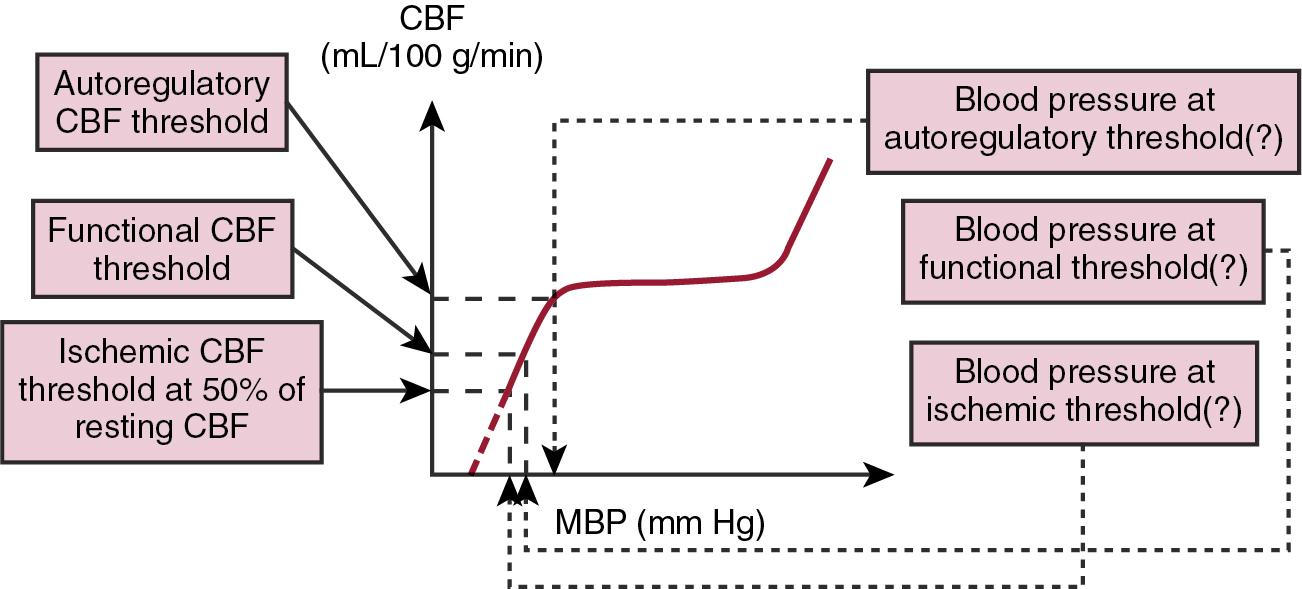
First, the mean blood pressure associated with the loss of CBF autoregulation is the generally accepted definition of hypotension ( autoregulatory blood pressure threshold ). Indeed, there is considerable information in the literature indicating that CBF autoregulation is functional, albeit with a narrow range, in normotensive but not in hypotensive VLBW neonates in the immediate postnatal period ( Fig. 2.4 ). , , Also of interest is that CBF velocity increases in a pressure-passive fashion as systolic blood pressure is increased with dopamine during the first postnatal day. A study found that cerebral pressure passivity in the VLBW neonatal population was associated with an increased risk for periventricular/intraventricular hemorrhage (P/IVH). These findings implicate blood pressure and pressure passivity as risk factors for intracranial pathology.
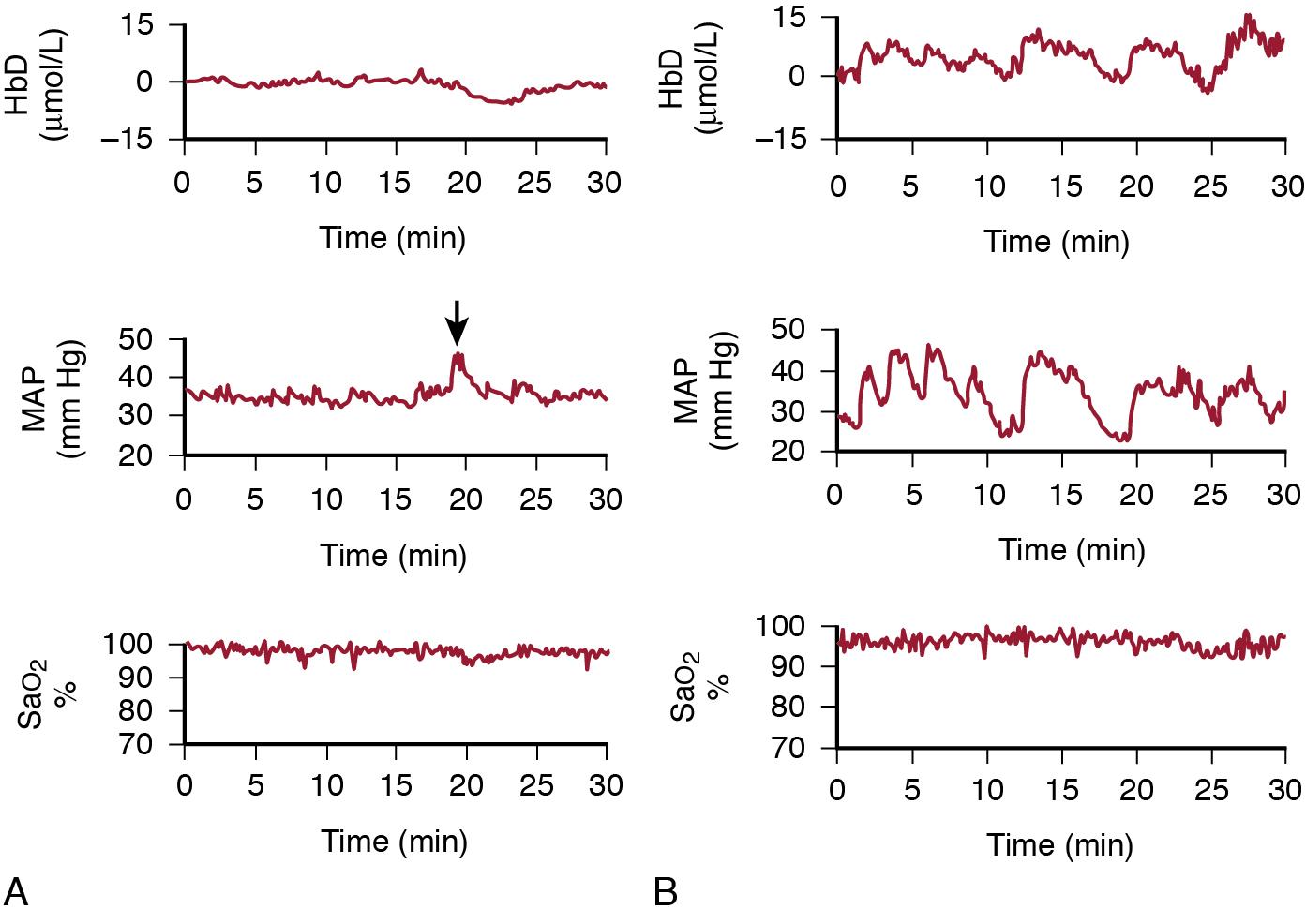
Autoregulation is the ability of the arteries to constrict or dilate in response to an increase or decrease, respectively, in the transmural pressure to maintain blood flow relatively constant within a range of arterial blood pressure changes (see Fig. 2.4 ). However, in the neonate, the vascular response has a limited capacity. In addition, and as mentioned above, the autoregulatory blood pressure range is narrow in the neonatal patient population with the 50th percentile of the mean blood pressure being relatively close to the lower autoregulatory blood pressure threshold. In other words, small decreases in blood pressure may result in loss of CBF autoregulation, especially in the VLBW infant. Available data suggest that the autoregulatory blood pressure threshold is around 28–29 mm Hg even in the extremely LBW (ELBW) neonate during the first postnatal day ( Fig. 2.5 ). , At and just below this blood pressure, However, cellular function and structural integrity are unlikely to be affected, because increased cerebral fractional oxygen extraction (CFOE), microvascular vasodilation, and a shift in the hemoglobin-oxygen dissociation curve to the left can maintain tissue oxygen delivery at levels appropriate to sustain cellular function and integrity. ,
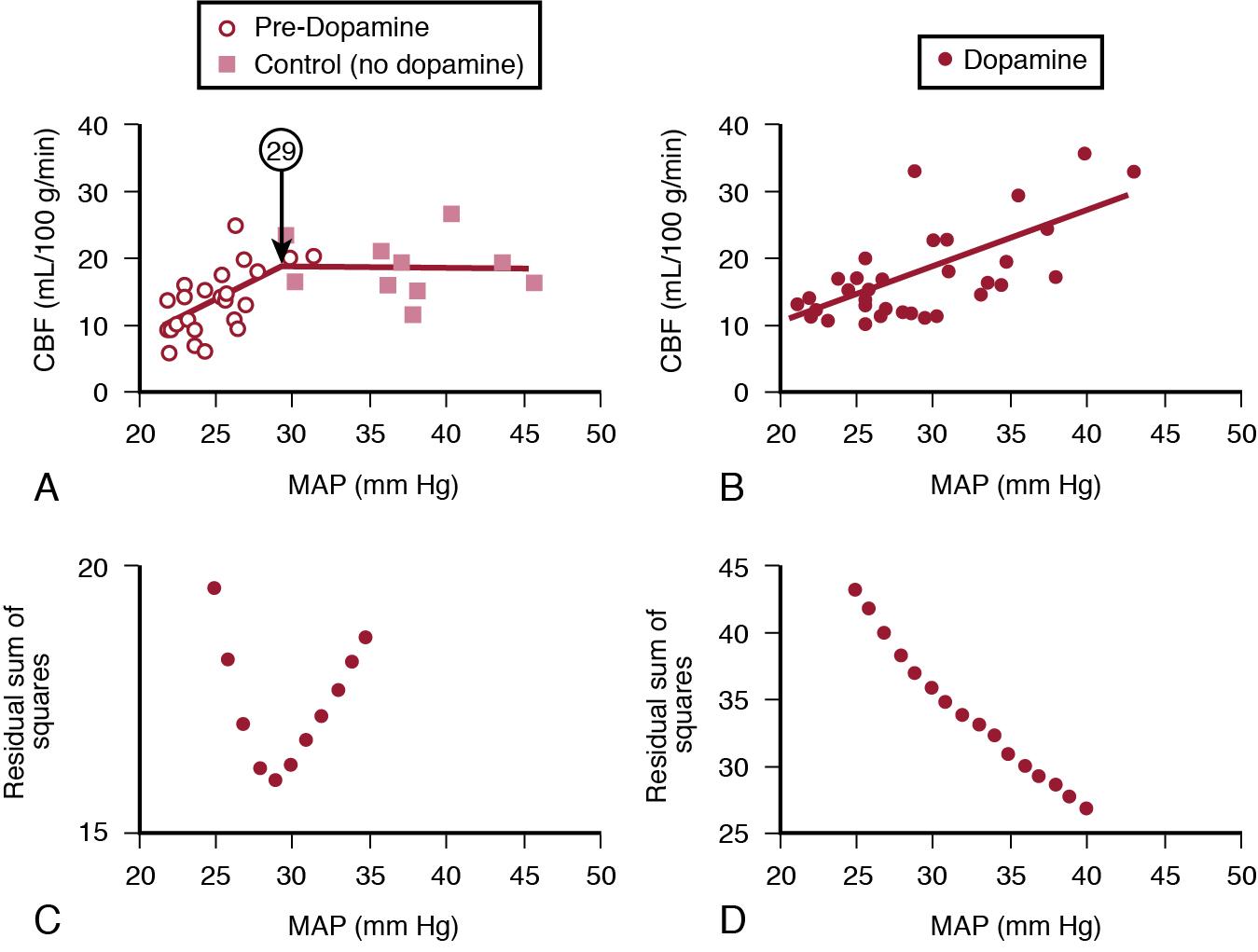
If blood pressure continues to fall, it reaches a value at which cerebral function becomes compromised ( functional blood pressure threshold ). Data suggest that the functional blood pressure threshold may be around 22 to 24 mm Hg in the VLBW neonate during the first postnatal days ( Fig. 2.6 ). , However, caution is needed when interpreting these findings obtained in a small number of preterm infants, as their clinical relevance is unclear. Furthermore, the relationship between cerebral electrical activity, neurodevelopmental outcome, and the threshold of CBF associated with impaired brain activity is not known.
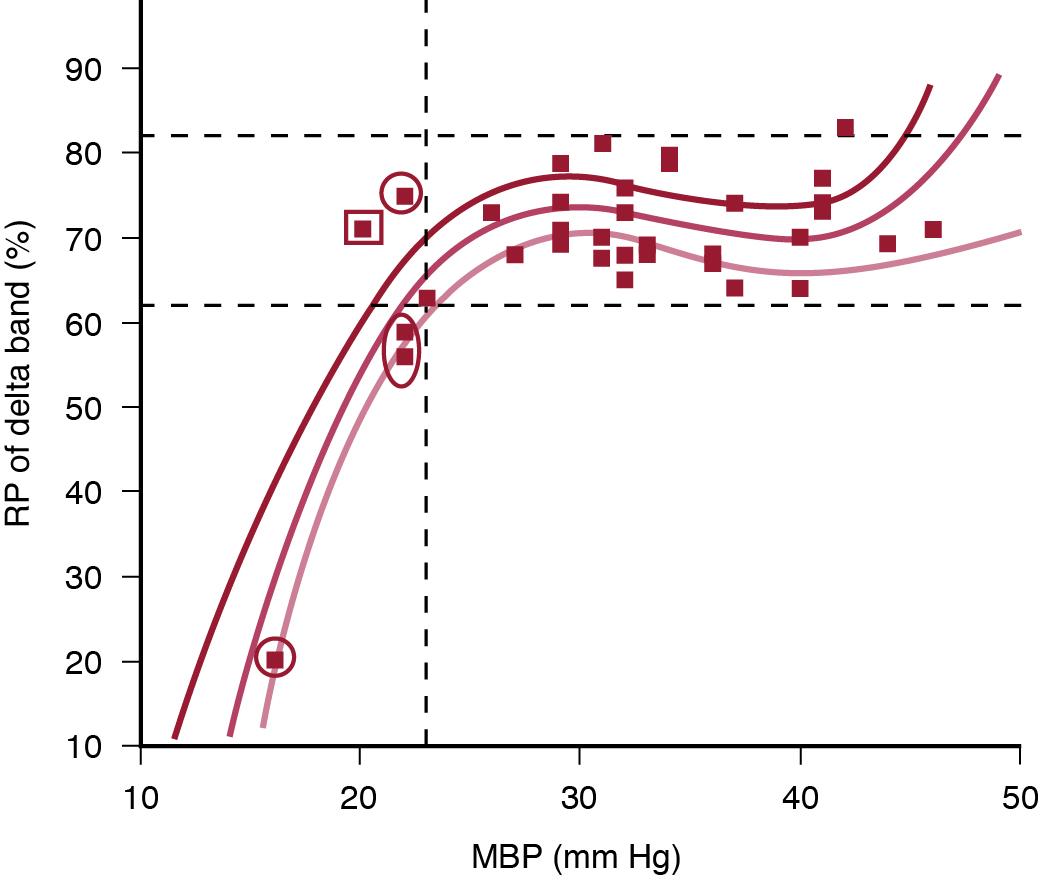
Finally, if blood pressure decreases even further, it reaches a value at which brain tissue structural integrity becomes compromised ( ischemic blood pressure threshold ). On the basis of findings in immature animals, it is assumed that the ischemic CBF threshold is around 50% of resting CBF. Although it is unclear what blood pressure value represents the ischemic CBF threshold in the VLBW neonate during the first postnatal day, it may be at or below 20 mm Hg (see Fig. 2.3 ). , It is important to emphasize that the situation is further complicated by the fact that these numbers represent moving targets for the individual patient influenced by their ability to compensate for decreases in blood pressure and oxygen delivery. In addition, other factors, such as the different sensitivity of brain structures to perfusion changes, Pa co 2 levels, the presence of acidosis, preexisting insults (asphyxia), and underlying pathophysiology (sepsis, anemia) all have an impact on the critical blood pressure value at which perfusion pressure and cerebral oxygen delivery cannot satisfy cellular oxygen demand to sustain autoregulation, then cellular function, and finally structural integrity.
In addition to using the three thresholds described above, two other approaches have been proposed to define the physiologically important blood pressure threshold. These are based on identifying the cerebrovascular critical closing pressure and monitoring cerebrovascular reactivity. Cerebrovascular critical closing pressure is defined as the arterial blood pressure at which CBF ceases. This blood pressure value can be estimated by analyzing simultaneously obtained systemic blood pressure and Doppler-derived CBF velocity (e.g., in the middle cerebral artery) waveforms and using an equation of impedance to flow velocity. , As the critical closing pressure is affected by the intracranial pressure and vascular properties, it could theoretically define the hypoperfusion blood pressure threshold for a specific patient at a particular time. A recent study used the diastolic closing margin defined as diastolic blood pressure minus critical closing pressure to investigate the development of early severe P/IVH. Interestingly, a higher diastolic closing margin was associated with severe P/IVH, which the authors considered as evidence for a hyperperfusion injury. Therefore, this study could not demonstrate a utility for using the critical closing pressure to identify the presence of cerebral hypoperfusion that often precedes developing P/IVH. However, as the concept of critical closing pressure is physiologically relevant, it merits further investigation.
To define the optimal MAP by using cerebrovascular reactivity, the tissue oxygenation-heart rate reactivity index needs to be first calculated. This index represents the correlation between the slow waves of the NIRS-defined cerebral tissue oxygenation index (TOI) and the slow fluctuations in the heart rate. As heart rate is one of the determinants of cardiac output, a positive correlation with the TOI is thought to indicate changes in cerebral circulation in response to changes in cardiac output. Therefore its positive correlation with the TOI suggests impaired cerebrovascular reactivity (regulation). Conversely, a zero or negative correlation is suggestive of intact cerebrovascular reactivity (regulation). Accordingly, the optimal MAP can be defined as the MAP associated with the lowest tissue oxygenation heart rate reactivity index in an individual for a given period. Recently, the optimal MAP averaged over the first 24 postnatal hours was calculated in 44 extremely preterm infants. The mean deviation below the optimal MAP was higher in infants who developed P/IVH and those who died. In contrast, the same investigators earlier reported that an MAP greater than optimal MAP by at least 4 mm Hg to be associated with severe P/IVH. As hypoperfusion-reperfusion precedes the occurrence of P/IVH, the observed deviations below and above the optimal MAP leading to P/IVH may be indicative of exposure to episodes of hypoperfusion and reperfusion, respectively. Further studies are needed to validate the concept of “optimal MAP.”
In most units, continuous monitoring of blood pressure and assessment of indirect signs of tissue perfusion (urine output, CRT, and lactic acidosis) still form the basis for identifying the presence of cardiovascular compromise. As discussed earlier though, “adequate” blood pressure may not always guarantee adequate organ perfusion in VLBW neonates especially during the first postnatal day. Indeed, blood pressure only weakly correlates with superior vena cava (SVC) flow in VLBW neonates during the period of immediate postnatal adaptation. Of note is that SVC flow has increasingly been used in the clinical practice as a surrogate for systemic blood flow in the VLBW neonate during the immediate postnatal period, when shunting through the fetal channels prohibits the use of left ventricular output to assess systemic blood flow. The finding that adequate blood pressure may not always guarantee adequate systemic blood flow in these patients may be explained, at least in part, by the notion that the cerebral vascular bed, especially of the 1-day-old ELBW neonate, may not be of high priority assignment yet and thus it will constrict, as do the vessels do in the nonvital organs, rather than dilate in response to a decrease in the perfusion pressure (see below). ,
Fluctuations in CBF are implicated in the pathogenesis of P/IVH and PWMI in the VLBW infant. , , , Both systemic and local (intracerebral) factors play a role in the pathogenesis of these central nervous system injuries and therefore are important to establish the underlying pathogenesis. In addition, the level of maturity, postnatal age, and intercurrent clinical factors (e.g., infection/inflammation, vasopressor-resistant hypotension) need to be also considered. In this section, we briefly discuss the monitoring parameters that are currently in widespread clinical use (systemic arterial pressure and arterial blood gas sampling) and then delve into the emerging field of bedside monitoring of systemic and organ blood flow, especially CBF and brain activity. We review most of the existing technologies, including echocardiography and Doppler ultrasound, impedance electrical cardiometry (IEC), NIRS, and aEEG, and discuss the applicability and limitations of these modalities. We do not discuss the use of magnetic resonance imaging (MRI) for assessing CBF in the neonatal patient population, because this topic is beyond the scope of this chapter.
A logical place to begin the discussion on monitoring CBF in the VLBW infant is to ask, “What is the normal CBF in the VLBW infant?” Several investigators have addressed this issue. It is clear from these studies that CBF is lower in preterm infants than in adults, corresponding to the lower metabolic rate of the preterm brain. A study using xenon-133 clearance found that, in 42 preterm infants with a mean gestational age of 31 weeks, CBF was 15.5 ± 7.2 mL/100 g/min during the first postnatal week, a value three to four times lower than that in adults. Interestingly, patients enrolled in this study who were receiving mechanical ventilation had lower CBF than their nonventilated counterparts and those supported on CPAP (11.8 ±3.2 vs. 19.8 ±5.3 and 21.3 ±12 mL/100 g/min, respectively). CBF in this study was not consistently affected by postnatal age, gestational age, birth weight, mode of delivery, Pa co 2 , hemoglobin concentration, mean blood pressure, or phenobarbital therapy. In contrast, subsequent publications by the same group of authors investigating CBF reactivity in preterm infants during the first three postnatal days showed that, as expected, Pa co 2 and hemoglobin concentration significantly affect CBF in this patient population. However, the relationship between Pa co 2 and CBF appears to be also affected by postnatal age during the immediate postnatal period (see below). Using positron emission tomography (PET) to measure CBF, a study found lower values for CBF in preterm and term neonates compared to those obtained by the use of xenon-133 clearance. More importantly, the authors reported that, in one term and five preterm infants with CBF between 4.9 and 10 mL/100 g/min, the term neonate and three of the preterm infants had normal neurodevelopmental outcome at 24 months. These data suggest but do not prove that the “neurodevelopmentally safe” lower limit of CBF in the neonate may be between 5 and 10 mL/100/min. Finally, and as also mentioned earlier, because CBF is affected by many factors other than blood pressure, it is not possible to define the blood pressure value consistently associated with a decrease of CBF below the “safe” limit that results in ischemic brain injury.
Kluckow and Evans, using SVC flow as a surrogate for CBF, established normal values of SVC flow during the first 48 postnatal hours in well preterm neonates younger than 30 weeks of gestation who were receiving minimal ventilatory support. However, it must be stated that the extent to which SVC flow is representative of systemic or CBF in preterm neonates during the first postnatal days is not understood. In a subsequent study that included sick preterm infants younger than 30 weeks of gestation, the same group found that 38% of infants had a period of low SVC in the first 24 postnatal hours. The incidence of low SVC flow was significantly related to the level of immaturity, and more than 70% of low SVC flow occurred in very preterm neonates (less than 27 weeks’ gestation). The sudden increase in the peripheral vascular resistance caused by the loss of the low-resistance placental circulation when the cord is clamped immediately after delivery, the complex process of cardiorespiratory transition to the postnatal circulatory pattern, and myocardial and autonomic central nervous system immaturity have all been proposed to contribute to these findings. Indeed, these factors may explain why many of these very preterm neonates struggle to maintain normal systemic blood flow during the first 12 to 24 postnatal hours. Of note is that using “physiologic” (delayed, for at least 30–60 seconds) rather than immediate cord clamping, immediate postnatal hemodynamic transition and the incidence of associated cerebral pathologies have changed. , Although physiologic cord clamping and other strategies to enhance placental transfusion do not alter the rate of severe P/IVH (grade III and IV), they do decrease the overall rate of P/IVH. The lower incidence of P/IVH with physiologic cord clamping may be due to improved postnatal cardiovascular adaptation. In addition, the higher intravascular volume may mitigate or attenuate cerebral hypoperfusion prevalent in the extremely preterm infants during the immediate transitional period, thereby decreasing the risk of P/IVH. An intriguing and potentially important finding of the SVC studies was that a proportion of the very preterm babies with extremely low SVC flow was found to have systemic blood pressures in the “normal” range (i.e., equal to or greater than their gestational age in weeks), a finding supported by subsequent studies of this group of researchers. , , Because normal blood pressure and decreased organ blood flow to nonvital organs are the hallmarks of the compensated phase of shock and because a portion of SVC flow represents blood returning from the brain, a vital organ, it is conceivable that that the proposed low-priority vessel (“nonvital organ”) assignment of the vascular beds of the forebrain (cerebral cortex and white matter) in the very preterm neonate during the immediate postnatal period explain these findings. This hypothesis, which is supported by studies in different animal models , and also, indirectly, in the human neonate , , may explain, at least in part, why SVC blood flow may be decreased in some very preterm neonates who have normal systemic blood pressure. Most preterm neonates with documented low SVC flow in the first 24 to 48 hours that do not go on to have P/IVH or PWMI are more mature (28 weeks and beyond vs. 25–26 weeks’ gestation). Thus for preterm infants of less than 30 weeks’ gestation, preexisting low systemic blood flow (and CBF) may be necessary but not sufficient to cause intracranial pathology. Importantly, all patients studied had an increase in SVC flow by 24 to 36 hours, and all P/IVHs occurred after the SVC flow had increased. Findings of a later prospective observational study by our group using echocardiography and NIRS confirm and expand these observations. In this study, very preterm neonates who presented with lower systemic blood flow and higher cerebral vascular resistance during the first 12 postnatal hours were at a higher risk for the development of P/IVH. Importantly, the bleeding occurred only after cardiac output and brain blood flow had increased. In addition, lower cerebral tissue oxygenation levels detected by NIRS during the first 12 postnatal hours might identify the patients who will subsequently develop P/IVH. Taken together, these findings implicate an ischemia-reperfusion cycle in the pathogenesis of P/IVH in very preterm neonates during the immediate transitional period.
It is important to note that the methods used to assess systemic and CBF in VLBW neonates in the immediate transitional period have significant limitations. When SVC flow is used to assess systemic and CBF, the measurements are operator dependent owing to the uncertainties associated with the accurate measurement of vessel diameter and flow velocity. The fluctuations in vessel size during the cardiac cycle and the flow velocity pattern in the SVC are important factors contributing to these technical difficulties. In addition, the shape of the SVC, the lack of data on the magnitude of the contribution of CBF to SVC flow in the human neonate, and the lack of a documented association between Pa co 2 and SVC flow in this patient population call for caution in the interpretation of these findings.
Yet, an association has been found between SVC flow and aEEG indices of oxygen utilization (continuity and amplitude) in the first 48 postnatal hours. Finding of this study also demonstrated that hypotension, either treated or untreated, was associated with decreased levels of brain activity as assessed by aEEG. This finding supports the previously referenced data , , indicating that blood pressure and brain oxygen utilization are inextricably linked.
In another study, CBF was measured in both the internal carotid and vertebral arteries and the sum of the flow in the four arteries supplying the brain was used to assess the changes in CBF volume in preterm infants of 28 to 35 weeks of gestation over the first 2 postnatal weeks. Although the technique, again, has significant limitations, the findings suggest that a steep rise in CBF occurs from the first to the second postnatal day and that this pattern is independent of gestational age. Thereafter, CBF continues to rise gradually ( Fig. 2.7 ). Because brain weight does not significantly increase during the first 48 postnatal hours, the investigators inferred that the observed increase in CBF during that period was secondary to increased cerebral perfusion per unit weight of tissue. On the other hand, the more gradual increase over the ensuing 2 weeks is likely due to a combination of increased brain weight, increased cerebral metabolic rate, and increased perfusion. , This study enrolled only “healthy” preterm infants with normal brains, whereas investigations in other studies , , , included a group of preterm infants who were sicker and had a higher incidence of significant intracranial pathology. Nevertheless, the results in the two groups of patients are complementary as they provide evidence for a decreased CBF in the first postnatal day, followed by a significant increase by the second postnatal day. Although low CBF in the first postnatal day and the ensuing “reperfusion” appears to be a physiologic phenomenon likely occurring in all very preterm neonates, CBF is even lower in those who later develop P/IVH. Therefore, the phenomenon of low CBF is also a necessary but not sufficient cause of intracranial pathology (P/IVH or PWMI) in this patient population. Interestingly, the difference in CBF may be present as early as the first few minutes after birth. A case-control study showed lower cerebral oxygen saturation in the “P/IVH group” from 7 minutes after birth compared to the “no-P/IVH control group” despite having similar arterial oxygen saturation. This difference may be related to a lower CBF or hemoglobin in the P/IVH group. Similarly, a prospective study showed lower cerebral oxygen saturation in the delivery room among the four patients who later developed severe P/IVH or died in the first 72 postnatal hours. However, these four patients also had higher mean airway pressure and lower arterial oxygen saturation, and as such, the lower cerebral oxygen saturation may simply reflect the poor respiratory status of these patients. Finally, although the vast majority of studies found low CBF on the first exam performed during the first few hours after birth, some have described a decrease in CBF at 12 hours compared to 3 to 6 hours after delivery. , The reason for the discrepancy in the findings is unclear at present.
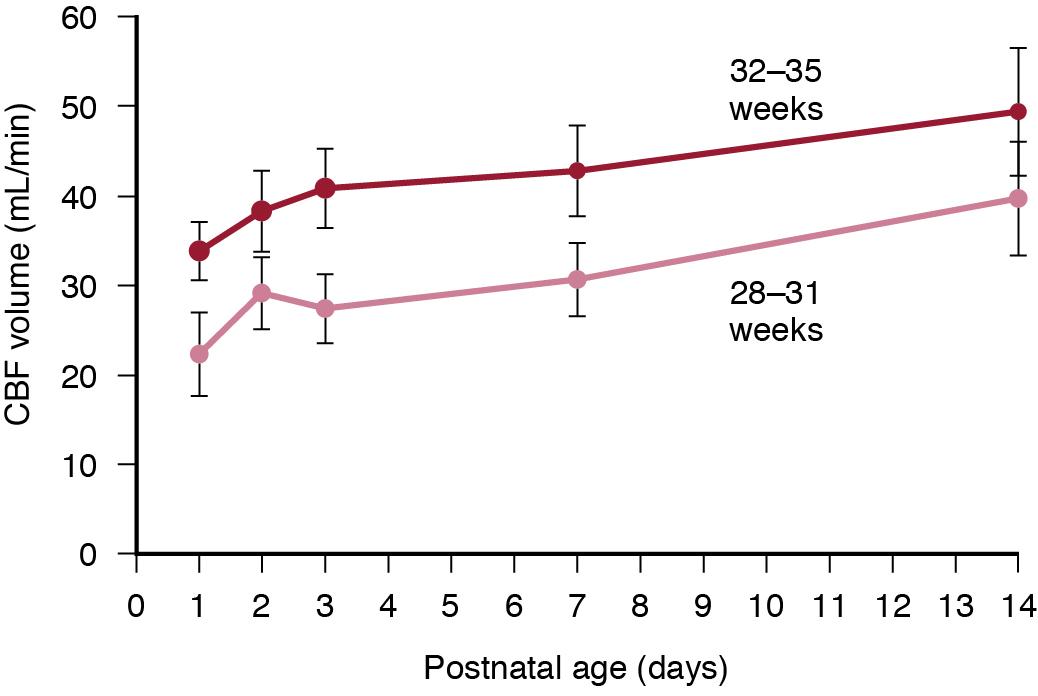
The ultimate goal is to improve neurodevelopmental outcome in preterm infants. In addition to the association between low SVC flow in the early postnatal period and P/IVH, low SVC flow in the early postnatal period is also independently associated with impaired neurologic outcome at 3 years of age. Therefore, infants most at risk must be identified in the immediate postnatal period. In addition to ultrasonography, NIRS and other monitoring modalities may be helpful in this regard. Indeed and as mentioned earlier, preterm infants who develop P/IVH have a pattern of changes in cerebral regional tissue oxygen saturation and oxygen extraction that is different from those without at risk for P/IVH. Thus combining different systemic and organ blood flow and tissue oxygenation monitoring technologies may be helpful in the early identification of infants at greater risk for the development of intracerebral pathologies.
It is clear from the large number of epidemiologic and hemodynamic studies that the level of immaturity is one of the most important predisposing factors for the occurrence of more abrupt changes in CBF and the increased vulnerability during postnatal adaptation and for poor neurologic outcome. Therefore, assessment of CBF during the first 24 to 48 postnatal hours in the most immature and vulnerable patients is important. However, owing to the technical difficulties associated with reliable and continuous assessment of CBF, clinical practice currently relies on indirect measures for diagnosis of changes in cerebral perfusion especially since the sole reliance on blood pressure in the indirect assessment of CBF in this patient population during the first postnatal day is not appropriate.
In addition to blood pressure, monitoring of the indirect clinical indicators of tissue perfusion such as urine output, CRT, and acid-base status in routine clinical practice remains important. Although these indirect clinical indicators by themselves are fairly nonspecific for evaluating systemic flow, using CRT and blood pressure together results in greater sensitivity. Indeed, when blood pressure and CRT are less than 30 mm Hg and 3 seconds or higher, respectively, the sensitivity for identifying low systemic blood flow is 86%. In addition, avoidance of both hypocapnia and hypercapnia is of utmost importance because of their effect on CBF. However, and as mentioned earlier, the manifestation of the effect of Pa co 2 on CBF appears to be dependent on postnatal age. A study reported a gradual change in the relationship between Pa co 2 and middle cerebral artery mean velocity, a surrogate for CBF, from none on the first day to the expected positive linear pattern by the third postnatal day. Others have also described an attenuated relationship on the first postnatal day with an increase in the reactivity of CBF to CO 2 during the following days. , Finally, inappropriately high intrathoracic pressure and elevated right heart pressure may also increase the risk of the development of P/IVH by impeding cerebral venous drainage. A recent study showed that altered internal cerebral venous flow pattern is associated with an increased rate of P/IVH. In addition to the increased intrathoracic and right atrial pressures, high blood pressure and PDA have also been associated with altered internal cerebral venous flow. However, the underlying mechanisms of this association are unclear.
Blood pressure is invasively and continuously monitored in most critically ill neonates using an indwelling arterial catheter and a calibrated pressure transducer. Available techniques are more likely to be used for systemic blood flow and CBF monitoring are ultrasound (echocardiography and Doppler ultrasound), electrical impedance, and NIRS. As for continuous monitoring of cerebral function in neonates, aEEG has also been increasingly used at the bedside. We briefly discuss these modalities used for systemic and organ blood flow monitoring in the following sections with a primary focus on those that can be performed noninvasively at the bedside.
Velocity of blood flow can be measured through the use of the Doppler principle, which states that the change in frequency of reflected sound is proportional to the velocity of the passing object (in this case, blood). The calculated velocity needs to be corrected for the angle between the vessel and the emitted sound beam (angle of insonation), and the straightforward idea is complicated by the fact that arterial blood is pulsatile, and its speed varies within the vessel (i.e., it is faster in the center of the vessel). It is important to recognize that speed of blood (distance traveled per unit time) in a vessel means little by itself; we are interested in the absolute blood flow (volume per unit time). Thus volumetric measurements are crucial and can be obtained by the product of velocity time integral (VTI) and cross-sectional area of the vessel that the blood travels in. Investigators have used several different volumetric indices, including SVC, internal carotid artery, and vertebral artery flow, as previously discussed. , The limitations of SVC flow measurements were discussed earlier. In general, major technical problems with volumetric measurements include but are not restricted to the small size of the vessels, the motion of vessel wall, and whether or not an angle of insonation of less than 20 degrees can be achieved. In addition to volumetric measurements of vessel blood flow, right ventricular and left ventricular outflow measurements have excessively been studied. However, both are fraught with pitfalls in the very preterm neonate in the immediate postnatal period, because the patent foramen ovale (PFO) and patent ductus arteriosus (PDA) represent shunts that confound measurements of the right ventricular and left ventricular flows, respectively. It is believed that right ventricular output may be a more reliable indicator of systemic blood flow during the immediate postnatal period with the fetal channels open, because shunting through the PFO is less significant than PDA shunting during the first 24 postnatal hours. Indeed, right ventricular output and systemic blood pressure have been correlated with EEG parameters (brain function) in VLBW infants in the immediate postnatal period. Ultrasound techniques are noninvasive and widely accessible in the intensive care setting and can be done at the bedside. The procedure itself minimally affects hemodynamic and physiological variables of the infant. However, all ultrasound measurements are noncontinuous, operator dependent, and have their significant limitations. As for the issues related to operator skills, centers utilizing these methods to diagnose pathologic CBF in neonates must have a rigorous quality control system in place with neonatologists trained in functional echocardiography and available at the bedside at any time.
With regard to the limitations to the use of vascular Doppler ultrasonography in assessing organ blood flow, the most important limitation is the small size of the artery of interest (e.g., middle or anterior cerebral artery), which precludes accurate measurement of its diameter. As previously mentioned, the estimation of blood flow (Q) depends on assessment of mean velocity of the blood (V) and the vessel diameter (D) (Q = V(πD 2 /4) × 60); any small error in measuring the diameter will translate into a significant error in estimating the actual blood flow. Therefore, instead of directly measuring blood flow, investigators often use changes in various Doppler-derived indices, such as mean blood flow velocity or the pulsatility or resistance index, as surrogates for changes in blood flow. This approach is based on the premise that the vessel diameter remains constant despite the changes in blood flow. However, this concept in not universally accepted. Nevertheless, both animal and human studies have shown an acceptable correlation between these indices and other measures of blood flow.
Finally, although normative data for the Doppler ultrasonography–derived indices for various vessels are available, the previously described limitations require caution in the interpretation of a single measurement. Rather, repeated measurements and the use of trends over time are thought to be more informative of the hemodynamic status and the changes in organ blood flow.
Become a Clinical Tree membership for Full access and enjoy Unlimited articles
If you are a member. Log in here